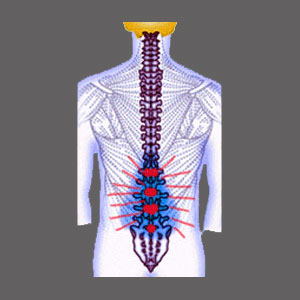
Cauda equina syndrome spinal stenosis is a literal medical emergency which affects some terribly unfortunate patients each and every year. True cauda equina can only occur from lumbar spinal stenosis, although similarly dire and symptomatic events can also occur due to cervical spinal stenosis. Cauda equina syndrome involves compression of the nerve roots which separate off the spinal cord in the upper lumbar spinal region. The most typical place for compression of one or more of these nerves to occur is at L4, L5 or S1, which are also the most frequent locations for structural back pain to be diagnosed in the human anatomy.
This discussion focuses on cauda equina syndrome and how it can be created by stenotic changes in the middle and lower lumbar regions. We will also investigate how cervical stenosis can cause strikingly similar symptoms in some patients.
Lumbar Cauda Equina Syndrome Spinal Stenosis
Lumbar central canal stenosis is the source of true cauda equina syndrome. This can be sourced slowly, over time, or immediately, from a sudden event like a back injury or acute herniated disc. Most surgical emergencies are caused by such unexpected and rapid stenosis conditions caused by herniated discs and fractured vertebrae.
Arthritic change causing spinal stenosis can also source cauda equina, but usually not in such a sudden and dramatic way. An alternate manner in which cauda equina syndrome can come about due to lumbar stenosis is from a sudden vertebral shift associated with spondylolisthesis.
Cauda Equina Syndrome Spinal Stenosis or Cervical Spinal Stenosis?
The spinal cord exists in the cervical region, unlike in the lower lumbar region. Therefore, compression on the cord will not cause cauda equina syndrome, although the symptoms may be incredibly similar or even identical.
Cervical cord compression is the most dangerous type of stenosis which can exist, since the location is so high and therefore potentially widely affective in the anatomy. Remember, the higher in the spine stenosis occurs, the worse its possible effects will truly be.
In rare cases, stenosis in the thoracic spine can enact cauda equina type symptoms as well, although these events are far less common, since thoracic spinal stenosis is the least seen type of canal narrowing and accounts for only a tiny percentage of diagnosed patients.
Cauda Equina Syndrome Spinal Stenosis Cautions
The symptoms of actual cauda equina syndrome, and other types of higher level spinal cord compression, can be very close in expression and may include any or all of the following:
Urinary or fecal incontinence may result suddenly or gradually. Constipation, or the inability to urinate at all, despite a seeming need, may also strike acutely or develop over time.
Weakness or numbness in the lower body, including the legs and/or feet, is almost a universal symptom of cauda equina.
Patient may have not be able to stand or walk without falling.
Patient may or may not have severe lower back pain and sciatica.
If you demonstrate any of these symptoms and have reason to suspect a cauda equina or spinal cord compression causation, do not delay. Get emergency medical attention ASAP, since the longer the effects of these horrific conditions endure, the greater the chances for permanent nerve or spinal cord injury to occur.
Spinal Stenosis > Symptoms of Spinal Stenosis > Cauda Equina Syndrome Spinal Stenosis





